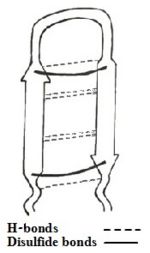Tachyplesin
From Proteopedia
(Difference between revisions)
m |
|||
| Line 38: | Line 38: | ||
TP-I undergoes confirmation change in <scene name='67/671725/Tp_i_in_the_presence_of_lps/1'>presence of LPS </scene>. The backbone of the polypeptide becomes <scene name='67/671725/Conformation_change/5'>more rigid and twisted in presence of LPS, than in the presence of water </scene>, making it more stable. | TP-I undergoes confirmation change in <scene name='67/671725/Tp_i_in_the_presence_of_lps/1'>presence of LPS </scene>. The backbone of the polypeptide becomes <scene name='67/671725/Conformation_change/5'>more rigid and twisted in presence of LPS, than in the presence of water </scene>, making it more stable. | ||
| - | |||
| - | == Mode of action == | ||
| - | TP-I has affinity to LPS and also has ability to permeabilize the cell membrane of pathogens. Docking model suggests strong affinity between TP-I and LPS; gained by interaction between cationic residues of TP-I with phosphate group and sachharides of LPS. Furthermore, interaction between hydrophobic residues of TP-I with acyl chains of LPS strengthens the TP-I/LPS interaction. The binding of TP-I/LPS neutralizes LPS, which is widely considered as endotoxin, and disrupts membrane function. In addition to LPS binding, footpriting analysis has revealed the binding of TP-I to DNA by interacting specifically in minor groove of DNA duplex. The interaction between TP-I and DNA is contributed by secondary structure of the peptide which contains an antiparallel beta-sheet constrained by two disulfide bridges and connected by β-turn <ref name=Yonezawa>PMID:1372516</ref>. | ||
| - | |||
| - | == Importance and relevance == | ||
| - | Evidences suggest that TP-1 has ability to permeabilize the cell membranes of pathogens.<ref name=Laederach>PMID:12369825</ref>. Also, LPS and DNA being the potential biological targets of the peptide, its antimicrobial activity might be exploited. Eyeing the potential of TP-1, it has been insetred successfully in genome of ''Ornithogalum dubium'' and ''Ornithogalum thyrsoides''. These ornamentals plants were originally sensitive to soft rot erwinias (SREs) and insertion of TPI in the plants has successfully protected them without affecting their normal physiology <ref name=Lipsky>PMID:25438795</ref>. | ||
== A Cys Deleted Linear Analog == | == A Cys Deleted Linear Analog == | ||
| Line 59: | Line 53: | ||
The interactions between CDT and LPS may lead to a plausible disruption or fluidization of LPS structures facilitating traversal of the peptide through the LPS-outer membrane.<ref name=Saravanan>PMID:22464970</ref> | The interactions between CDT and LPS may lead to a plausible disruption or fluidization of LPS structures facilitating traversal of the peptide through the LPS-outer membrane.<ref name=Saravanan>PMID:22464970</ref> | ||
| + | == Mode of action == | ||
| + | TP-I has affinity to LPS and also has ability to permeabilize the cell membrane of pathogens. Docking model suggests strong affinity between TP-I and LPS; gained by interaction between cationic residues of TP-I with phosphate group and sachharides of LPS. Furthermore, interaction between hydrophobic residues of TP-I with acyl chains of LPS strengthens the TP-I/LPS interaction. The binding of TP-I/LPS neutralizes LPS, which is widely considered as endotoxin, and disrupts membrane function. In addition to LPS binding, footpriting analysis has revealed the binding of TP-I to DNA by interacting specifically in minor groove of DNA duplex. The interaction between TP-I and DNA is contributed by secondary structure of the peptide which contains an antiparallel beta-sheet constrained by two disulfide bridges and connected by β-turn <ref name=Yonezawa>PMID:1372516</ref>. | ||
| + | |||
| + | == Importance and relevance == | ||
| + | Evidences suggest that TP-1 has ability to permeabilize the cell membranes of pathogens.<ref name=Laederach>PMID:12369825</ref>. Also, LPS and DNA being the potential biological targets of the peptide, its antimicrobial activity might be exploited. Eyeing the potential of TP-1, it has been insetred successfully in genome of ''Ornithogalum dubium'' and ''Ornithogalum thyrsoides''. These ornamentals plants were originally sensitive to soft rot erwinias (SREs) and insertion of TPI in the plants has successfully protected them without affecting their normal physiology <ref name=Lipsky>PMID:25438795</ref>. | ||
| + | |||
== Possible Function as anti-tumor peptide == | == Possible Function as anti-tumor peptide == | ||
Revision as of 14:06, 5 January 2015
Introduction
| |||||||||||
References
- ↑ 1.0 1.1 1.2 Laederach A, Andreotti AH, Fulton DB. Solution and micelle-bound structures of tachyplesin I and its active aromatic linear derivatives. Biochemistry. 2002 Oct 15;41(41):12359-68. PMID:12369825
- ↑ 2.0 2.1 PMID:11289111
- ↑ Nakamura, Takanori, et al. "Tachyplesin, a class of antimicrobial peptide from the hemocytes of the horseshoe crab (Tachypleus tridentatus). Isolation and chemical structure." Journal of Biological Chemistry 263.32 (1988): 16709-16713
- ↑ Kushibiki T, Kamiya M, Aizawa T, Kumaki Y, Kikukawa T, Mizuguchi M, Demura M, Kawabata SI, Kawano K. Interaction between tachyplesin I, an antimicrobial peptide derived from horseshoe crab, and lipopolysaccharide. Biochim Biophys Acta. 2014 Jan 2;1844(3):527-534. doi:, 10.1016/j.bbapap.2013.12.017. PMID:24389234 doi:http://dx.doi.org/10.1016/j.bbapap.2013.12.017
- ↑ 5.0 5.1 Saravanan R, Mohanram H, Joshi M, Domadia PN, Torres J, Ruedl C, Bhattacharjya S. Structure, activity and interactions of the cysteine deleted analog of tachyplesin-1 with lipopolysaccharide micelle: Mechanistic insights into outer-membrane permeabilization and endotoxin neutralization. Biochim Biophys Acta. 2012 Mar 23;1818(7):1613-1624. PMID:22464970 doi:10.1016/j.bbamem.2012.03.015
- ↑ Yonezawa A, Kuwahara J, Fujii N, Sugiura Y. Binding of tachyplesin I to DNA revealed by footprinting analysis: significant contribution of secondary structure to DNA binding and implication for biological action. Biochemistry. 1992 Mar 24;31(11):2998-3004. PMID:1372516
- ↑ Lipsky A, Cohen A, Ion A, Yedidia I. Genetic transformation of Ornithogalum via particle bombardment and generation of Pectobacterium carotovorum-resistant plants. Plant Sci. 2014 Nov;228:150-8. doi: 10.1016/j.plantsci.2014.02.002. Epub 2014 Feb, 12. PMID:25438795 doi:http://dx.doi.org/10.1016/j.plantsci.2014.02.002
Proteopedia Page Contributors and Editors (what is this?)
Shulamit Idzikowski, Janak Raj Joshi, Michal Harel, Alexander Berchansky, Joel L. Sussman, Angel Herraez, Jaime Prilusky

